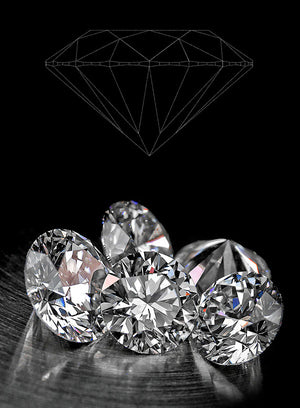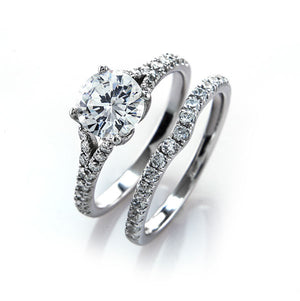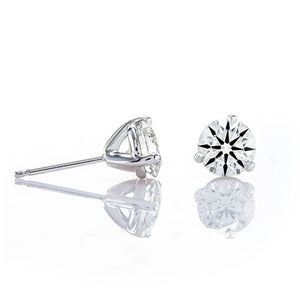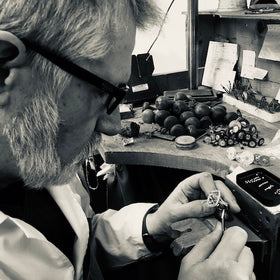
The Hearts and Arrows diamond is a "super-ideal" cut version of the traditional 57 faceted round brilliant cut.
Find Hearts & Arrows Diamonds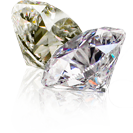
Diamond Color
Table of Contents
- Introduction
- History
- How Color Ratings are Done
- Cut vs. Color
- Familiarize yourself with diamond color
- Fancy Colors
Introduction
Though the full beauty and essence of a diamond are revealed best through a perfect cut, its color affects its character and value. A stone’s color is influenced by minute amounts of trace elements other than carbon that were present when the stone was being formed over thousands of years, deep the earth. A diamond’s color grade is actually determined by its “lack” of color. Under normal lighting conditions, most diamonds appear to be colorless the naked eye. Many consumers think that all diamonds are colorless, however, in reality, they come in a wide range of colors. Actual color differences are very subtle. The “normal” color range of commercial diamonds is from colorless (white) to light yellow and light brown. The color of a diamond is also influenced by the tone and saturation of color, and the intensity of a diamond’s brilliance, which results in the depth of the stone’s color.
Within the same color range, diamonds can differ slightly. As diamonds become larger their color becomes more noticeable. Small diamonds, commonly known as melee, are harder to color grade and are often represented within a color range e.g. D - F. To know what color grade you are comfortable with, go and look at some diamonds side by side. Remember to compare GIA or AGS graded diamonds so that you can be sure of the color you are actually seeing. Diamonds that have been color graded by other diamond laboratories may not have been as accurately graded. Another factor that can influence perceived color is fluorescence. Fluorescence is the emission of visible light by the diamond when it is exposed to ultraviolet radiation. This is an innate property of the rough diamond before it has been cut and polished.
History
The diamond color grading system used today, was developed by Richard T. Liddicoat at the Gemological Institute of America in the 1950’s. Today, the GIA color scale is the most widely used color grading system worldwide. Their color grades range from D to Z (“D” has the least color; “Z” has the most), and the higher the color grade, the higher the value of the diamond. The AGS uses numerical values for color with 0 being equal to D, E is 0.5, F is 1 and so on.
How Color Ratings are Done
Diamond color is graded in controlled lighting conditions, with the diamond face down, and viewed looking through the pavilion (the bottom half of the diamond). The “whiter” the diamond, the higher the color grade it receives. Color grading is relatively subjective. And a diamond’s grade might vary from one grader to the next, depending on the environment, any color variation of the light source being used, and the set of master stones being used as benchmarks for color comparison. If a diamond’s color is very close to a color grade threshold, its rating can vary, higher of lower, according to the grader’s perception and circumstances.
Even within the same color range, diamonds can differ slightly. As diamonds become larger their color becomes more noticeable. Small diamonds, commonly known as melee, are harder to color grade and are often represented within a color range, e.g. between D - F. Even under bright unnatural lighting, such as found in a jewelry store, it can be difficult to discern small variations in a diamond’s color, unless you compare, side by side, two stones with a wide color variation.
Cut vs. Color
A mounted diamond shows less color than it does loose, because its color is influenced by the color of the metal used for its setting and the ambient color lighting. “Performance” is a more noticeable and significant feature than color when selecting a diamond. A round brilliant cut like that on our Brian Gavin Signature Hearts and Arrows diamonds returns more light to the eye and shows less color than a lesser quality cut stone. As a result, with a well-cut diamond, you can afford to go with a lower color grade and have a better performing and more brilliant stone. Our average customer buys a diamond with a color rating between H - J.
Familiarize yourself with diamond color.
Look at a variety of diamonds side by side to know what color grade you are comfortable with. Remember to compare GIA or AGS graded diamonds so that you can be sure of the accuracy of the color you are seeing. Diamonds that have been color graded by other diamond laboratories may not have been as accurately graded.

Diamond Color grading scale D to J
FANCY COLORS
Naturally colored diamonds outside the normal color range are called fancy-colored diamonds. Fancy colored diamonds are either yellow or brown diamonds that exhibit more color than a Z master stone or they are any color other than yellow or brown. Colors may include red, purple, green, pink, blue and orange. Yellows and browns are more common. Unlike colorless diamonds, the value of fancy colored diamonds increases as the color deepens. Since the color scales are too varied to have a set of master stones, standard color references are used and then the color grade is assigned based on the variance in saturation.

Fancy Colored Diamonds: Fancy Pink, Fancy Red, Fancy Green and Fancy Yellow





